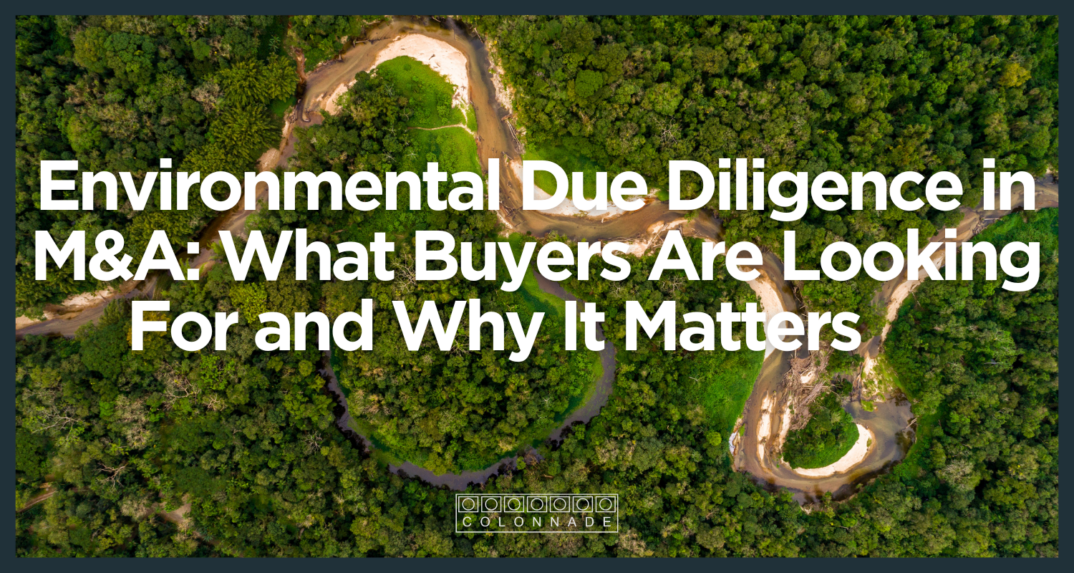Environmental Due Diligence in M&A: What Buyers Are Looking For and Why It Matters

Environmental risks are easy to overlook—until they become deal-breakers. Whether you’re buying, selling, financing, or developing a business with physical assets, environmental due diligence is a non-negotiable part of the process.
At Colonnade Advisors, we’ve seen firsthand how a lack of environmental clarity can delay or derail a transaction. That’s why we work closely with buyers and sellers to ensure environmental diligence is thorough, organized, and forward-looking.
In this post, we’ll walk through the two primary types of environmental site assessments (ESAs)—Phase I and Phase II—and explore additional documentation that buyers often request to evaluate a company’s environmental footprint and compliance history.
🧪 Phase I Environmental Site Assessment (ESA)
What it is:
A Phase I ESA is a non-intrusive investigation to identify whether there is a risk of environmental contamination on a property. It’s often required by lenders and is the first step in protecting against environmental liability.
What’s Reviewed:
- Historical land use records (e.g., aerial photos, city directories, fire insurance maps)
- Federal/state/local environmental databases (e.g., EPA reports, hazardous site listings)
- A physical site inspection (no soil/water sampling)
- Interviews with current and former owners, tenants, and local officials
- Adjacent property use and potential contamination sources
Time to Complete:
~2–4 weeks, depending on property complexity and access to records.
Purpose:
To determine whether there is a Recognized Environmental Condition (REC)—meaning actual or potential contamination. If no REC is found, the Phase I is complete. If there is an REC, a Phase II ESA is recommended.
🧪 Phase II Environmental Site Assessment
What it is:
A follow-up to a Phase I ESA, a Phase II involves on-site sampling and testing to confirm whether contamination is present and to quantify its extent.
What’s Reviewed:
- Soil, groundwater, and vapor samples collected from the site
- Testing of specific “areas of concern” flagged in the Phase I
- Lab analysis for pollutants (e.g., heavy metals, hydrocarbons, solvents)
- Comparative analysis against regulatory limits and cleanup thresholds
- Time to Complete:
- ~2–6 weeks, depending on the scope of testing and lab turnaround.
Purpose:
To determine whether remediation is necessary—and, if so, to support cost estimates, regulatory filings, or insurance coverage.
Phase I vs. Phase II: Key Differences
| Feature | Phase I ESA | Phase II ESA |
| Intrusive? | No | Yes (sampling involved) |
| Purpose | Identify potential environmental issues | Confirm contamination |
| Activities | Records review, site visit, interviews | Soil/water/vapor sampling |
| Triggered by? | Due diligence, financing, compliance | Findings in Phase I (RECs) |
| Time to Complete | 2–4 weeks | 2–6 weeks (or more) |
🧾 Additional Environmental Documentation Reviewed in Diligence
Buyers (and their legal counsel) often request supporting documentation to assess the company’s environmental practices and compliance posture. These may include:
- Third-Party Audits: Past environmental audits performed by consultants
- Evidence of self-reporting or remediation steps taken
- Regulatory Inspection Reports: Records from EPA, OSHA, state, or local inspections
- Notices of violation or enforcement actions
- MSDS / SDS (Material Safety Data Sheets):
- Safety documentation for all hazardous substances used or stored onsite: Required under OSHA’s Hazard Communication Standard; indicates how the company handles chemical exposure, spill response, and safety training
- Environmental Policies & Procedures
- Hazardous materials handling
- Waste disposal
- Emergency spill response
- Water usage, air emissions, sustainability programs
- Permits & Licenses
- Wastewater discharge, stormwater, hazardous materials handling, Clean Water Act (CWA), Clean Air Act (CAA) permits
- Incident & Spill Reports: Records of leaks, spills, or accidental discharges, including how they were managed
- Underground Storage Tank (UST) Documentation: Removal reports, compliance tests, registration with state agencies
- Hazardous Waste Records: Manifests, transporter logs, and contracts with disposal companies
🔍 Why Environmental Due Diligence Matters in a Deal
- Financial Risk: Contamination can come with major cleanup costs and long-term liabilities—especially if government agencies get involved.
- Legal Compliance: Environmental violations can result in fines or injunctions that delay operations or new development.
- Insurance Limitations: Environmental issues may be excluded from coverage if not properly disclosed during underwriting.
- Deal Breakers: In severe cases, buyers will walk away rather than take on environmental liabilities that weren’t disclosed early.
Final Thoughts: Be Proactive, Be Prepared
Environmental issues can be complex, but surprises are avoidable. By conducting a Phase I ESA early and organizing your records—permits, audits, MSDS, spill reports—you can present a clean, transparent profile to potential acquirers.
If contamination is found, a Phase II ESA can help quantify the issue and inform next steps, whether that’s remediation, insurance claims, or negotiation adjustments.
📩 Want to get ahead of environmental diligence? Colonnade Advisors works with clients to prepare clean data rooms, manage risk disclosures, and position their operations for successful transactions. Let’s talk!


